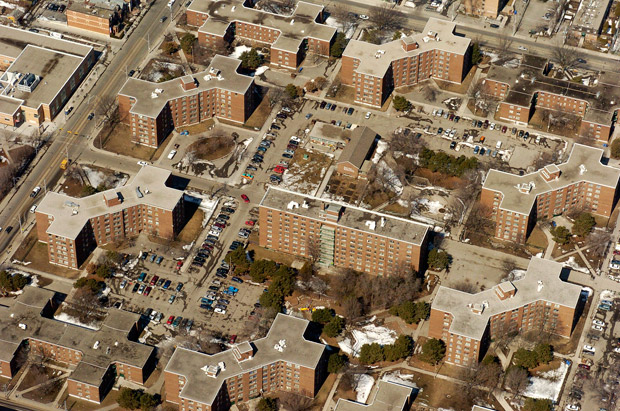TORONTO – Duelling images of gang violence and a community attempting revitalization has once again thrust one of Toronto’s most notorious neighbourhoods back into the spotlight.

A brazen shooting at the Eaton Centre earlier this month has spurred conversations about renewed violence in Regent Park, as the alleged shooter Christopher Husbands and two shooting victims reportedly had links to Sic Thugs, a street gang based out of Regent Park.
Meanwhile, plans to revitalize the area plough ahead as community groups try to shake neighbourhood’s violent image from the collective consciousness.
Global News takes a closer look at the history of Regent Park.
LOCATION
Located in Old Toronto, Regent Park is bordered by Parliament Street to the west, Gerrard St. E to the north, Shuter Street to the south and River Street to the east.
The area now known as Regent Park was originally called Cabbagetown for the vegetables grown on front lawns in the area. The nickname Cabbagetown now refers to the wealthier area to the north of Regent Park.
ORIGINS
Regent Park is Canada’s oldest social housing project, with construction beginning in 1948. However, planning for Regent Park began years earlier.
The original Cabbagetown was established in the 1840s and overtime became one of Toronto’s most rundown neighbourhoods, inhabited primarily by Irish immigrants.
The working class neighbourhood became increasing impoverished following the First World War.

Get daily National news
Shortly after the Second World War, city officials decided to clear the worst of Toronto’s slums.
The decision was put to a vote and in 1947 residents endorsed the plan to raze Cabbagetown and rebuild from scratch.
“GARDEN CITY”
Regent Park was designed to be a “garden city,” with buildings placed in a “pastoral” setting, facing inwards and turning their backs on the noise of the city.
Streets were replaced with walkways and green space, making the area largely inaccessible to traffic.
The design was also completely residential, containing no commercial and recreational facilities.
And so, people who did not live in Regent Park had very little reason to go there.
The abundant green space in the area also led to confusion over where private property ended and public property began. Regent Park’s “pastoral” setting turned into a no-man’s land of sorts.
What resulted was that the area and its 7,500 residents became isolated from the rest of the city. And some 50 years would pass as the neighbourhood fell into disrepair.
SOCIAL ISSUES
When the Regent Park construction began in the late 1940s the area was inhabited mostly with Irish and British immigrants. Throughout the 1970s large numbers of immigrants arriving from Southeast Asia, China and the Caribbean came to Regent Park.
A city of Toronto report says that today 60 per cent of residents are immigrants and the neighbourhood is home to more than 70 languages.
Originally Regent Park only permitted two-parent families to live in the units. But by the 1970s, these families had begun moving out of the area. By the time of the 1976 census, one in seven households in Regent Park was headed by a single parent.
These changing demographics changed the social interactions between residents. Cultural conflicts became more common and tensions rose. A reports published in the mid-70s cited a lack of recreational facilities, bored youth and socioeconomic factors as reasons for the neighbourhood conflicts.
Regent Park in the late 80s and early 90s was characterized by drug problems taking root. Drug crimes and violent crimes increased.
Tensions rose between residents and police officers from 51 Division, with many residents viewing the cops as aggressors during their many enforcement blitzes.
In August 1995 tensions reached a boiling point when hundreds of residents and police officers clashed in what is now known as the “Riot in Regent Park.”
Toronto Police Chief Bill Blair, who at the time was the newly appointed superintendent of 51 Division, instituted new methods of policing in Regent Park to improve community relations. He assigned beat officers who would walk the area and spend time in local schools and churches.
The community-oriented policing reportedly improved the atmosphere in the neighbourhood, although some tension still remained.
Residents in Regent Park have faced continual economic hardships, racism and negative stereotyping. According to Statistics Canada data, Regent Park is one of the poorest neighbourhoods in Canada, with nearly 70 per cent of residents living below StatsCan’s low-income cut-off rate.
“Our tenants are probably some of the most vulnerable in Toronto,” says Len Koroneos from Toronto Community Housing.
The city of Toronto says that as of 2007, fewer than 150 households made over $30,000 a year.
HOUSING & REVITALIZATION
After numerous attempts to launch redevelopment plans in the 90s, Toronto City Council formally endorsed the blueprint for a new Regent Park in 2003.
Demolition began in 2006 and the entire project should last approximately ten to 15 years.
The revitalization project will see the replacement of over 2,000 rent-geared-to-income (RGI) units and the addition of 700 new affordable housing units and 3,000 market condominium units.
The residential structures will be a mix of townhouses and mid-to-high-rise apartment buildings.
The revitalization project also includes plans to reconnect the roadways and introduce new community centres and retail facilities as well as parks and pedestrian-friendly streets.
The community rec centre and pool is slated to open within weeks.
Before the current revitalization plan began, Regent Park was made up of 2,083 RGI units, inhabited by 7,500 residents. After the revitalization phases are complete, the area population is expected to reach 12,500 residents in a mixed-income and mixed-use community.








Comments